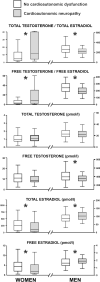Sex differences and sex steroids influence on the presentation and severity of cardiovascular autonomic neuropathy of patients with type 1 diabetes
- PMID: 36793089
- PMCID: PMC10127589
- DOI: 10.1186/s12933-023-01766-y
Sex differences and sex steroids influence on the presentation and severity of cardiovascular autonomic neuropathy of patients with type 1 diabetes
Abstract
Background: Sex differences characterize cardiovascular outcomes in patients with type 1 diabetes. Cardioautonomic neuropathy is a common complication of type 1 diabetes that associates increased morbi-mortality. Data regarding the interplay between sex and cardiovascular autonomic neuropathy are scarce and controversial in these patients. We aimed to address sex-related differences in the prevalence of seemingly asymptomatic cardioautonomic neuropathy in type 1 diabetes, and their associations with sex steroids.
Methods: We conducted a cross-sectional study including 322 consecutively recruited patients with type 1 diabetes. Cardioautonomic neuropathy was diagnosed using Ewing's score and power spectral heart rate data. We assessed sex hormones by liquid chromatography/tandem mass spectrometry.
Results: When considering all subjects as a whole, asymptomatic cardioautonomic neuropathy prevalence was not significantly different between women and men. When age was taken into account, the prevalence of cardioautonomic neuropathy was similar among young men and those > 50 years. However, in women > 50 years, the prevalence of cardioautonomic neuropathy doubled that of young women [45.8% (32.6; 59.7) vs. 20.4% (13.7; 29.2), respectively]. The OR of having cardioautonomic neuropathy was 3.3 higher in women > 50 years than in their younger counterparts. Furthermore, women presented more severe cardioautonomic neuropathy than men. These differences were even more marked when women were classified according their menopausal status instead of age. Peri- and menopausal women had an OR 3.5 (1.7; 7.2) of having CAN compared with their reproductive-aged counterparts [CAN prevalence: 51% (37; 65) vs. 23% (16; 32), respectively]. A binary logistic regression model (R2: 0.161; P = 0.001) displayed age > 50 years as a significant determinant of cardioautonomic neuropathy only in women. Androgens were positively associated with heart rate variability in men, and negatively in women. Accordingly, cardioautonomic neuropathy was associated with increased testosterone/estradiol ratio in women but to decreased testosterone concentrations in men.
Conclusions: Menopause in women with type 1 diabetes is accompanied by an increase in the prevalence of asymptomatic cardioautonomic neuropathy. This age-related excess risk of cardioautonomic neuropathy is not observed in men. Men and women with type 1 diabetes have opposite associations between circulating androgens and indexes of cardioautonomic function. Trial registration ClinicalTrials.gov Identifier: NCT04950634.
Keywords: Autonomic nervous system; Cardioautonomic neuropathy; Cardiovascular disease; Sex differences; Sex hormones; Sex steroids; Sexual dimorphism; Type 1 diabetes mellitus.
© 2023. The Author(s).
Conflict of interest statement
The authors declare that there is no competing interests that could be perceived as prejudicing the impartiality of the research reported.
Figures



References
-
- Regensteiner JG, Golden S, Huebschmann AG, Barrett-Connor E, Chang AY, Chyun D, Fox CS, Kim C, Mehta N, Reckelhoff JF, et al. Sex differences in the cardiovascular consequences of diabetes mellitus: a scientific statement from the american heart association. Circulation. 2015;132(25):2424–2447. doi: 10.1161/CIR.0000000000000343. - DOI - PubMed
-
- Jaiswal M, Divers J, Urbina EM, Dabelea D, Bell RA, Pettitt DJ, Imperatore G, Pihoker C, Dolan LM, Liese AD, et al. Cardiovascular autonomic neuropathy in adolescents and young adults with type 1 and type 2 diabetes: the SEARCH for diabetes in youth cohort study. Pediatr Diabetes. 2018;19:680–689. doi: 10.1111/pedi.12633. - DOI - PMC - PubMed
-
- Nattero-Chávez L, Alonso Díaz S, Jiménez-Mendiguchia L, García-Cano A, Fernández-Durán E, Dorado Avendaño B, Escobar-Morreale HF, Luque-Ramírez M. Sexual dimorphism and sex steroids influence cardiovascular autonomic neuropathy in patients with type 1 diabetes. Diabetes Care. 2019;42(11):e175–e178. doi: 10.2337/dc19-1375. - DOI - PubMed
Publication types
MeSH terms
Substances
Associated data
LinkOut - more resources
Full Text Sources
Medical

